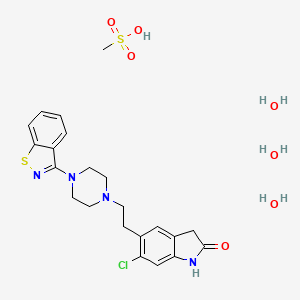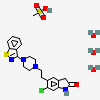Ziprasidone Mesylate
- 199191-69-0
- Ziprasidone mesylate
- Geodon
- Ziprasidone mesilate
- Ziprasidone mesylate trihydrate
- Create:2005-06-24
- Modify:2025-01-11
 Ziprasidone (has active moiety).
Ziprasidone (has active moiety).
- 5-(2-(4-(3-benzisothiazolyl)piperazinyl)ethyl)-6-chloro-1,3-dihydro-2H-indol-2-one
- CP 88059
- CP 88059-01
- CP-88,059
- CP-88,059-01
- CP-88,059-1
- Geodon
- ziprasidone
- ziprasidone hydrochloride
- ziprasidone hydrochloride, monohydrate
- ziprazidone
- 199191-69-0
- Ziprasidone mesylate
- Geodon
- Ziprasidone mesilate
- Ziprasidone mesylate trihydrate
- Ziprasidone mesilate trihydrate
- UNII-3X6SAX83JZ
- Ziprasidone mesylate hydrate
- 3X6SAX83JZ
- Ziprasidone mesylate [USAN]
- CP-88, 059-27
- NSC-760351
- Ziprasidone mesylate - Bio-X
- Ziprasidone (mesylate hydrate)
- CHEBI:53757
- NSC 760351
- CP-8805927
- Geodon (TN)
- CP-88,059-27
- Ziprasidone mesylate (USAN)
- 2H-Indol-2-one, 5-(2-(4-(1,2-benzisothiazol-3-yl)-1-piperazinyl)ethyl)-6-chloro-1,3-dihydro-, monomethanesulfonate, trihydrate
- 5-[2-[4-(1,2-benzothiazol-3-yl)piperazin-1-yl]ethyl]-6-chloro-1,3-dihydroindol-2-one;methanesulfonic acid;trihydrate
- CP-88059-27
- ZIPRASIDONE MESILATE (MART.)
- ZIPRASIDONE MESILATE [MART.]
- 5-(2-(4-(1,2-Benzisothiazol-3-yl)-1-piperazinyl)ethyl)-6-chloro-2-indolinone monomethanesulfonate, trihydrate
- ZIPRASIDONE MESILATE TRIHYDRATE (EP MONOGRAPH)
- ZIPRASIDONE MESILATE TRIHYDRATE [EP MONOGRAPH]
- 5-[2-[4-(1,2-Benzisothiazol-3-yl)-1-piperazinyl]ethyl]-6-chloro-2-indolinone monomethanesulfonate, trihydrate
- Geodon, for Injection
- CHEMBL3989833
- Ziprasidone (mesylate trihydrate)
- BCP12408
- ZIPRASIDONE MESYLATE [VANDF]
- HY-14542B
- AKOS027379883
- CP88059
- BZ164581
- DA-59297
- ZIPRASIDONE MESYLATE [ORANGE BOOK]
- D02100
- A814073
- Q27124195
- 2H-INDOL-2-ONE, 5-(2-(4-(1,2-BENZISOTHIAZOL-3-YL)-1-PIPERAZINYL)ETHYL)-6-CHLORO-1,3-DIHYDRO-, METHANESULFONATE, HYDRATE (1:1:3)
- 5-[2-[4-(1,2-benzothiazol-3-yl)-1-piperazinyl]ethyl]-6-chloro-1,3-dihydroindol-2-one; methanesulfonic acid; trihydrate
- 5-[2-[4-(1,2-benzothiazol-3-yl)piperazin-1-yl]ethyl]-6-chloranyl-1,3-dihydroindol-2-one; methanesulfonic acid; trihydrate
 Ziprasidone (has active moiety)
Ziprasidone (has active moiety)

H317 (100%): May cause an allergic skin reaction [Warning Sensitization, Skin]
H373 (100%): May causes damage to organs through prolonged or repeated exposure [Warning Specific target organ toxicity, repeated exposure]
P260, P261, P272, P280, P302+P352, P319, P321, P333+P317, P362+P364, and P501
(The corresponding statement to each P-code can be found at the GHS Classification page.)
Skin Sens. 1 (100%)
STOT RE 2 (100%)
Patents are available for this chemical structure:
https://patentscope.wipo.int/search/en/result.jsf?inchikey=WLQZEFFFIUHSJB-UHFFFAOYSA-N
- ChEBIZiprasidone mesylate trihydratehttps://www.ebi.ac.uk/chebi/searchId.do?chebiId=CHEBI:53757
- NCI Thesaurus (NCIt)LICENSEUnless otherwise indicated, all text within NCI products is free of copyright and may be reused without our permission. Credit the National Cancer Institute as the source.https://www.cancer.gov/policies/copyright-reuseNCI Thesaurushttps://ncit.nci.nih.gov
- Open TargetsLICENSEDatasets generated by the Open Targets Platform are freely available for download.https://platform-docs.opentargets.org/licenceZIPRASIDONE MESYLATEhttps://platform.opentargets.org/drug/CHEMBL3989833
- ChEMBLLICENSEAccess to the web interface of ChEMBL is made under the EBI's Terms of Use (http://www.ebi.ac.uk/Information/termsofuse.html). The ChEMBL data is made available on a Creative Commons Attribution-Share Alike 3.0 Unported License (http://creativecommons.org/licenses/by-sa/3.0/).http://www.ebi.ac.uk/Information/termsofuse.html
- ChemIDplusZiprasidone mesylate [USAN]https://pubchem.ncbi.nlm.nih.gov/substance/?source=chemidplus&sourceid=0199191690ChemIDplus Chemical Information Classificationhttps://pubchem.ncbi.nlm.nih.gov/source/ChemIDplus
- European Chemicals Agency (ECHA)LICENSEUse of the information, documents and data from the ECHA website is subject to the terms and conditions of this Legal Notice, and subject to other binding limitations provided for under applicable law, the information, documents and data made available on the ECHA website may be reproduced, distributed and/or used, totally or in part, for non-commercial purposes provided that ECHA is acknowledged as the source: "Source: European Chemicals Agency, http://echa.europa.eu/". Such acknowledgement must be included in each copy of the material. ECHA permits and encourages organisations and individuals to create links to the ECHA website under the following cumulative conditions: Links can only be made to webpages that provide a link to the Legal Notice page.https://echa.europa.eu/web/guest/legal-notice5-{2-[4-(1,2-Benzothiazol-3-yl)-1-piperazinyl]ethyl}-6-chloro-1,3-dihydro-2H-indol-2-one methanesulfonate (1:1)https://echa.europa.eu5-{2-[4-(1,2-Benzothiazol-3-yl)-1-piperazinyl]ethyl}-6-chloro-1,3-dihydro-2H-indol-2-one methanesulfonate (1:1) (EC: 110-966-6)https://echa.europa.eu/information-on-chemicals/cl-inventory-database/-/discli/details/397058
- FDA Global Substance Registration System (GSRS)LICENSEUnless otherwise noted, the contents of the FDA website (www.fda.gov), both text and graphics, are not copyrighted. They are in the public domain and may be republished, reprinted and otherwise used freely by anyone without the need to obtain permission from FDA. Credit to the U.S. Food and Drug Administration as the source is appreciated but not required.https://www.fda.gov/about-fda/about-website/website-policies#linkingZIPRASIDONE MESYLATEhttps://gsrs.ncats.nih.gov/ginas/app/beta/substances/3X6SAX83JZ
- ClinicalTrials.govLICENSEThe ClinicalTrials.gov data carry an international copyright outside the United States and its Territories or Possessions. Some ClinicalTrials.gov data may be subject to the copyright of third parties; you should consult these entities for any additional terms of use.https://clinicaltrials.gov/ct2/about-site/terms-conditions#Use
- DailyMed
- Drugs@FDALICENSEUnless otherwise noted, the contents of the FDA website (www.fda.gov), both text and graphics, are not copyrighted. They are in the public domain and may be republished, reprinted and otherwise used freely by anyone without the need to obtain permission from FDA. Credit to the U.S. Food and Drug Administration as the source is appreciated but not required.https://www.fda.gov/about-fda/about-website/website-policies#linkingZIPRASIDONE MESYLATEhttps://www.accessdata.fda.gov/scripts/cder/daf/
- FDA Orange BookLICENSEUnless otherwise noted, the contents of the FDA website (www.fda.gov), both text and graphics, are not copyrighted. They are in the public domain and may be republished, reprinted and otherwise used freely by anyone without the need to obtain permission from FDA. Credit to the U.S. Food and Drug Administration as the source is appreciated but not required.https://www.fda.gov/about-fda/about-website/website-policies#linking
- KEGGLICENSEAcademic users may freely use the KEGG website. Non-academic use of KEGG generally requires a commercial licensehttps://www.kegg.jp/kegg/legal.htmlUSP drug classificationhttp://www.genome.jp/kegg-bin/get_htext?br08302.kegAnatomical Therapeutic Chemical (ATC) classificationhttp://www.genome.jp/kegg-bin/get_htext?br08303.kegTarget-based classification of drugshttp://www.genome.jp/kegg-bin/get_htext?br08310.keg
- National Drug Code (NDC) DirectoryLICENSEUnless otherwise noted, the contents of the FDA website (www.fda.gov), both text and graphics, are not copyrighted. They are in the public domain and may be republished, reprinted and otherwise used freely by anyone without the need to obtain permission from FDA. Credit to the U.S. Food and Drug Administration as the source is appreciated but not required.https://www.fda.gov/about-fda/about-website/website-policies#linking
- NLM RxNorm TerminologyLICENSEThe RxNorm Terminology is created by the National Library of Medicine (NLM) and is in the public domain and may be republished, reprinted and otherwise used freely by anyone without the need to obtain permission from NLM. Credit to the U.S. National Library of Medicine as the source is appreciated but not required. The full RxNorm dataset requires a free license.https://www.nlm.nih.gov/research/umls/rxnorm/docs/termsofservice.htmlziprasidone mesylatehttps://rxnav.nlm.nih.gov/id/rxnorm/353116
- Wikidataziprasidone mesylate trihydratehttps://www.wikidata.org/wiki/Q27124195
- PubChem
- Medical Subject Headings (MeSH)LICENSEWorks produced by the U.S. government are not subject to copyright protection in the United States. Any such works found on National Library of Medicine (NLM) Web sites may be freely used or reproduced without permission in the U.S.https://www.nlm.nih.gov/copyright.htmlziprasidonehttps://www.ncbi.nlm.nih.gov/mesh/67092292Antipsychotic Agentshttps://www.ncbi.nlm.nih.gov/mesh/68014150Dopamine Antagonistshttps://www.ncbi.nlm.nih.gov/mesh/68018492Serotonin Antagonistshttps://www.ncbi.nlm.nih.gov/mesh/68012702
- MolGenieMolGenie Organic Chemistry Ontologyhttps://github.com/MolGenie/ontology/
- PATENTSCOPE (WIPO)SID 389329256https://pubchem.ncbi.nlm.nih.gov/substance/389329256
- NCBI


 CID 6395 (Methanesulfonic Acid)
CID 6395 (Methanesulfonic Acid) CID 962 (Water)
CID 962 (Water)